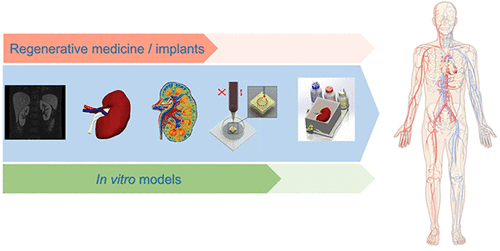当前位置:
X-MOL 学术
›
Chem. Rev.
›
论文详情
Our official English website, www.x-mol.net, welcomes your
feedback! (Note: you will need to create a separate account there.)
Bioprinting: From Tissue and Organ Development to in Vitro Models.
Chemical Reviews ( IF 51.4 ) Pub Date : 2020-05-14 , DOI: 10.1021/acs.chemrev.9b00789 Carlos Mota 1 , Sandra Camarero-Espinosa 1 , Matthew B Baker 1 , Paul Wieringa 1 , Lorenzo Moroni 1
Chemical Reviews ( IF 51.4 ) Pub Date : 2020-05-14 , DOI: 10.1021/acs.chemrev.9b00789 Carlos Mota 1 , Sandra Camarero-Espinosa 1 , Matthew B Baker 1 , Paul Wieringa 1 , Lorenzo Moroni 1
Affiliation

|
Bioprinting techniques have been flourishing in the field of biofabrication with pronounced and exponential developments in the past years. Novel biomaterial inks used for the formation of bioinks have been developed, allowing the manufacturing of in vitro models and implants tested preclinically with a certain degree of success. Furthermore, incredible advances in cell biology, namely, in pluripotent stem cells, have also contributed to the latest milestones where more relevant tissues or organ-like constructs with a certain degree of functionality can already be obtained. These incredible strides have been possible with a multitude of multidisciplinary teams around the world, working to make bioprinted tissues and organs more relevant and functional. Yet, there is still a long way to go until these biofabricated constructs will be able to reach the clinics. In this review, we summarize the main bioprinting activities linking them to tissue and organ development and physiology. Most bioprinting approaches focus on mimicking fully matured tissues. Future bioprinting strategies might pursue earlier developmental stages of tissues and organs. The continuous convergence of the experts in the fields of material sciences, cell biology, engineering, and many other disciplines will gradually allow us to overcome the barriers identified on the demanding path toward manufacturing and adoption of tissue and organ replacements.
中文翻译:

生物打印:从组织和器官发育到体外模型。
生物打印技术在生物制造领域蓬勃发展,在过去几年中取得了显着的指数级发展。用于形成生物墨水的新型生物材料墨水已经开发出来,可以制造体外模型和经过临床前测试的植入物,并取得一定程度的成功。此外,细胞生物学(即多能干细胞)的令人难以置信的进步也促成了最新的里程碑,其中已经可以获得具有一定功能的更相关的组织或器官样构建体。这些令人难以置信的进步是由世界各地的众多多学科团队实现的,他们致力于使生物打印的组织和器官更具相关性和功能。然而,要使这些生物制造的结构能够到达诊所,还有很长的路要走。在这篇综述中,我们总结了将它们与组织和器官发育和生理学联系起来的主要生物打印活动。大多数生物打印方法侧重于模仿完全成熟的组织。未来的生物打印策略可能会追求组织和器官的早期发育阶段。材料科学、细胞生物学、工程学和许多其他学科领域的专家的不断融合将逐渐使我们能够克服在制造和采用组织和器官替代品的艰巨道路上发现的障碍。
更新日期:2020-05-14
中文翻译:

生物打印:从组织和器官发育到体外模型。
生物打印技术在生物制造领域蓬勃发展,在过去几年中取得了显着的指数级发展。用于形成生物墨水的新型生物材料墨水已经开发出来,可以制造体外模型和经过临床前测试的植入物,并取得一定程度的成功。此外,细胞生物学(即多能干细胞)的令人难以置信的进步也促成了最新的里程碑,其中已经可以获得具有一定功能的更相关的组织或器官样构建体。这些令人难以置信的进步是由世界各地的众多多学科团队实现的,他们致力于使生物打印的组织和器官更具相关性和功能。然而,要使这些生物制造的结构能够到达诊所,还有很长的路要走。在这篇综述中,我们总结了将它们与组织和器官发育和生理学联系起来的主要生物打印活动。大多数生物打印方法侧重于模仿完全成熟的组织。未来的生物打印策略可能会追求组织和器官的早期发育阶段。材料科学、细胞生物学、工程学和许多其他学科领域的专家的不断融合将逐渐使我们能够克服在制造和采用组织和器官替代品的艰巨道路上发现的障碍。











































 京公网安备 11010802027423号
京公网安备 11010802027423号